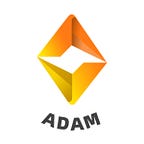Metauniverse and Web 3.0 Vision Cannot Be Separated from Infrastructure Services Facilities Such as ADAM
With the spread of the crypto bear market, the industry seems to have some faith collapsed, and few people are now leading the industry’s future in a loud voice. Metaverse and Web3.0 seem to have become slogans that people are no longer enthusiastic about. The downward spiral of the global economy and the continued surge of layoffs have become even more of a shadow hanging over all industries.
The more we are at the industry trough, the more we must firmly believe that the future is spiraling upward. Based on objective facts, the slow development of metaverse and Web3.0 is largely due to the imperfection of industry infrastructure services. At this stage, the mainstream public chain is closed, has insufficient throughput and suffers from transaction congestion. Decentralized digital identity is not unified, and the Internet of everything has not yet been realized. Moreover, technologies such as virtual reality, blockchain, decentralized storage, privacy computing and cross-border interaction remain immature. All these issues are hindering the implementation of the metaverse and Web 3.0 vision.
One of the most criticized aspects of the blockchain industry today is the scaling and latency issues of mainstream public chains. Vitalik Buterin once said, “The new cryptocurrency internet shouldn’t cost 5 cents per transaction.” The cost of gas for ethereum has been high for the past few years, and it may be a bit ironic for him to say that, but the view is still shared by most people. Even with clearer application scenarios and a more optimized user experience, if the transaction confirmation time and cost issues are not addressed, then the industry will still not be able to accommodate hundreds of millions of new users.
As we all know, the need to implement various applications of blockchain has become more and more urgent in the past few years, and various technical experts in the industry are working together to prioritize solving the performance problems of public chains such as ethereum. ADAM is also trying to reduce the congestion on public chains in the form of off-chain computing.
Despite the consensus, the technical progress of the industry doesn’t seem to be going that well. Expansion technologies that greatly increase TPS (transaction processing per second) have been proposed and discussed fluently, and Ethereum network continues to be congested. Although the Ethereum network was officially merged at block 5,537,393 on September 15, 2022, and its The Merge update has achieved extraordinary technical success, it is still far from the realization of the Metaverse and Web3.0.
As the most important public chain ecology in the industry, the development of Ethereum is directly related to the future direction of the industry, and it is one of the important infrastructure services for the meta-universe and Web3.0 to be able to land. Public chain is the underlying protocol of blockchain, and is the “operating system” of the blockchain world.
The good thing is the mainstream public chains such as Bitcoin and Ethereum have reached a consensus, focusing on gradually improving performance with practical methods. We can also see that many public chain projects are also implementing blockchain expansion through parallel computing, modular rollup, and side chains.
We are very happy to see the continued deep exploration of industry leaders, but it is also important to understand that nothing can be done overnight.
The public chain is an important foundation in the Metauniverse and Web3.0. However, the public chain is also in the early stage, and its infrastructure service facilities include oracle, distributed storage and decentralized identity, etc., which are also areas that need to be focused on. Public chain to enhance cross-chain interoperability with EVM equivalence is a priority. The realization of the Metauniverse also requires VR, AI, 3D rendering and other technologies to be closely integrated with blockchain technology.
Metauniverse is a virtual world constructed by humans using digital technology, which is mapped by or beyond the real world and can interact with the real world. The public chain is an infrastructure-level open blockchain built specifically for the metaverse and decentralized digital world, providing the necessary technical preparation and underlying development platform for metaverse developers. The data storage and transmission, NFT casting and splitting, distributed computing, rendering and other functions provided by the public chain bring us closer to the vision of Metaverse and Web3.0.
Before realizing Metaverse and Web3.0, the public chain still needs to be improved, and the public chain needs greater scalability to realize large-scale consumer applications. The metaverse as a whole is currently in the early stages of development, and the demand for infrastructure building is relatively strong. The demand comes from data storage and distribution, oracle, 3D, payment methods and identity credentials for the metaverse, cloud computing, etc. For now, the blockchain still has a long way to go to realize the real metaverse and Web3.0 in our minds.
However, from the perspective of current projects and adoption, there is still much room for progress in the construction of blockchain infrastructure and the combination with other metaverse-related technologies. We are currently in the stage of building and improving the underlying infrastructure, which requires a large-scale explosion of applications such as ADAM. When such infrastructure matures, the public chain ecology will also formally usher in a period of large-scale application landing, after which the metauniverse and Web3.0 will become possible to enter the next stage.
